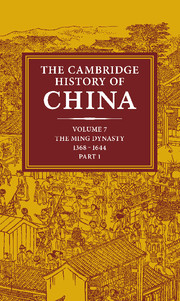Book contents
- Frontmatter
- Introduction
- 1 The rise of the Ming dynasty, 1330–1367
- 2 Military Origins of Ming China
- 3 The Hung-wu reign, 1368–1398
- 4 The Chien-wen, Yung-lo, Hung-hsi, and Hsüan-te reigns, 1399–1435
- 5 The Cheng-t'ung, Ching-t'ai, and T'len-shun reigns, 1436–1464
- 6 The Ch'eng-hua and Hung-chih reigns, 1465–1505
- 7 The Cheng-te reign, 1506–1521
- 8 The Chia-ching reign, 1522–1566
- 9 The Lung-ch'ing and Wan-li reigns, 1567–1620
- 10 The T'ai-ch'ang, T'ien-ch'i, and Ch'ung-chen reigns, 1620–1644
- 11 The Southern Ming, 1644–1662
- 12 Historical writing during the Ming
- Bibliographic notes
- Bibliography
- Glossary-index
- References
8 - The Chia-ching reign, 1522–1566
Published online by Cambridge University Press: 28 March 2008
- Frontmatter
- Introduction
- 1 The rise of the Ming dynasty, 1330–1367
- 2 Military Origins of Ming China
- 3 The Hung-wu reign, 1368–1398
- 4 The Chien-wen, Yung-lo, Hung-hsi, and Hsüan-te reigns, 1399–1435
- 5 The Cheng-t'ung, Ching-t'ai, and T'len-shun reigns, 1436–1464
- 6 The Ch'eng-hua and Hung-chih reigns, 1465–1505
- 7 The Cheng-te reign, 1506–1521
- 8 The Chia-ching reign, 1522–1566
- 9 The Lung-ch'ing and Wan-li reigns, 1567–1620
- 10 The T'ai-ch'ang, T'ien-ch'i, and Ch'ung-chen reigns, 1620–1644
- 11 The Southern Ming, 1644–1662
- 12 Historical writing during the Ming
- Bibliographic notes
- Bibliography
- Glossary-index
- References
Summary
THE EMPEROR'S SELECTION AND ACCESSION
Chu Hou-ts'ung, the eleventh emperor of the Ming dynasty, was born on 16 September 1507 on his father's estate in An-lu, Hu-kuang province (modern Chung-hsiang hsien in Hupeh). His father, Chu Yu-yüan (1476– 1519), the Prince of Hsing, was the fourth son of the Ch'eng-hua emperor (r. 1465 – 1487) and the eldest of three sons born to the emperor's concubine, Lady Shao. Fond of poetry and calligraphy, he refused to engage in many of the other leisure pursuits of his peers and indulged himself instead in artistic and literary pastimes. Lady Shao, the future emperor's grandmother, had been sold by her father to the eunuch intendant of Hangchow, who trained her to write and recite T'ang dynasty poetry and then presented her as a gift to the Ch'eng-hua emperor. At the time of her grandson's accession in 1521, she was a blind old woman living in retirement in the imperial laundry, a compound outside the Imperial City set aside for retired or disgraced palace women. The future emperor's mother, née Chiang (1477–1538), was the daughter of an officer in the Peking guard. Wed to the prince in 1492, she accompanied him to his estate in An-lu in 1494.
Historians of the reign had to note that the future emperor's birth was attended by the extraordinary and auspicious signs that marked such important people. They wrote, for example, that in the year of his birth the Yellow River remained clear for five days and that roseate clouds filled the skies, because such portents marked the birth of a legitimate emperor.
- Type
- Chapter
- Information
- The Cambridge History of China , pp. 440 - 510Publisher: Cambridge University PressPrint publication year: 1988
References
- 10
- Cited by

